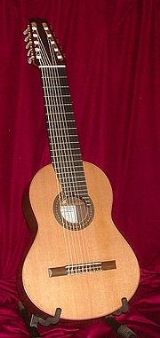
Ten-string extended-range classical guitar
Encyclopedia
- Ten-string classical guitar redirects here. For the romantic ten-string harp guitarHarp guitar]The harp guitar is a stringed instrument with a history of well over two centuries. While there are several unrelated historical stringed instruments that have appropriated the name “harp-guitar” over the centuries, the term today is understood as the accepted vernacular to refer to a particular...
or decacorde see Ten-string harp guitars.
The ten string extended-range classical guitar, with fully chromatic
Chromatic scale
The chromatic scale is a musical scale with twelve pitches, each a semitone apart. On a modern piano or other equal-tempered instrument, all the half steps are the same size...
, sympathetic string
Sympathetic string
Sympathetic strings or resonance strings are auxiliary strings found on many Indian musical instruments, as well as some Western Baroque instruments and a variety of folk instruments...
resonance
Sympathetic resonance
Sympathetic resonance is a harmonic phenomenon wherein a formerly passive string or vibratory body responds to external vibrations to which it has a harmonic likeness. The classic example is demonstrated with two similar tuning-forks of which one is mounted on a wooden box. If the other one is...
was conceived in 1963 by Narciso Yepes
Narciso Yepes
Narciso Yepes was a Spanish guitarist.-Biography:Yepes was born into a family of humble origin in Lorca, Region of Murcia. His father gave him his first guitar when he was four years old. He took his first lessons from Jesus Guevara, in Lorca...
, who "ordered the guitar from José Ramírez [III
José Ramírez III
José Ramírez III was a luthier and the grandson of José Ramírez, founder of Ramírez Guitars. He was responsible for major changes both to the company and to the classical guitars it produces....
]". This instrument is sometimes referred to as the "modern" 10-string guitar (or the "Yepes guitar") to differentiate it from ten-stringed harp guitars of the 19th century.
Today, ten-string instruments to Ramírez' original design remain available from the Ramírez Company, and similar instruments in a variety of designs are available both from the Ramírez Company and other luthiers, notably from Paulino Bernabe Senior
Paulino Bernabe Senior
Paulino Bernabe Senior was a Spanish luthier.- Life :Born in Madrid, Paulino Bernabé received music lessons from Daniel Fortea, a pupil of Francisco Tárrega, and then learned the art of making classical guitars from José Ramírez III...
.
Background
In the early 1960s, luthier José Ramírez III considered adding sympathetic strings to the classical guitar. He sought advice from the leading classical guitarists of the time, notably Andrés SegoviaAndrés Segovia
Andrés Torres Segovia, 1st Marquis of Salobreña , known as Andrés Segovia, was a virtuoso Spanish classical guitarist from Linares, Jaén, Andalucia, Spain...
and Narciso Yepes, both of them players of Ramírez six-string guitars. Eventually they came up with a ten string guitar.

Tessitura
In music, the term tessitura generally describes the most musically acceptable and comfortable range for a given singer or, less frequently, musical instrument; the range in which a given type of voice presents its best-sounding texture or timbre...
. However, unlike earlier 6- or 10-stringed guitars, the normal tuning of the strings Yepes added "also incorporates all the natural resonance that the instrument lacked in eight of twelve notes of the equal tempered scale". As Yepes explains, the tuning of the Romantic ten-stringed guitars is "not exactly the same, because the tuning that I use is also for the resonance")
See also
- Ten-string guitarTen-string guitarThere are many varieties of ten-string guitar, including:* Both electric and acoustic guitars.* Instruments used principally for classical, folk and popular music.* Both coursed and uncoursed instruments.-Ten-stringed harp guitars:...
for all guitars with ten strings. - String resonance (music)String resonance (music)String resonance occurs on string instruments. Strings or parts of strings may resonate at their fundamental or overtone frequencies when other strings are sounded...
- Harmonic seriesHarmonic series (music)Pitched musical instruments are often based on an approximate harmonic oscillator such as a string or a column of air, which oscillates at numerous frequencies simultaneously. At these resonant frequencies, waves travel in both directions along the string or air column, reinforcing and canceling...
Further reading
- Ramírez, José. 1994. "The Ten-String Guitar". In Things About the Guitar. Madrid: Soneto Ediciones Musicales: pp. 137–140. ISBN 8487969402

